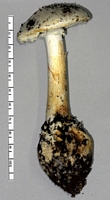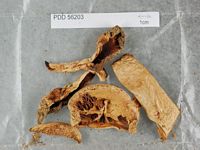|
 Amanita mumura Amanita mumura
BiostatusPresent in region - Indigenous. Endemic
Images (click to enlarge)
Caption: photo by Clive Shirley
Owner: J.A. Cooper | 
Caption: Dried type specimen
Owner: Herb PDD |
Article: Ridley, G.S. (1991). The New Zealand species of Amanita (Fungi: Agaricales). Australian Systematic Botany 4(2): 325-354.
Description: Basidiocarps small to medium, solitary. Pileus 45-64 mm, convex to piano-convex, margin appendiculate with friable volva remnants, dry, disc white to buff, pale fulvous sienna at margin, volva remnants forming complete, pulverulent, buff covering, occasionally completely eroded in older specimens. Lamellae crowded, free, 8 mm wide, white; lamellulae attenuate. Stipe 50-100 mm high, 10-32 mm diameter, clavate to sub-bulbous, hollow, smooth, buff with luteous and sienna fulvous stains, volva remnants coating the lower stipe and upper bulb in pulverulent to sub-felted, adnate layer, pale buff with luteous and sienna stains, occasionally forming spurious, inferior ring (seen only in Taylor 1168). Annulus friable, felted, disappearing in older specimens, buff to pale ochreous. Context of pileus and stipe pale buff, with some yellowing on exposure. On drying basidiocarp becoming rosy buff.
Spore print white. Basidiospores (53/5), (8-)9-12 x (6-)6.5-8.5 µm, Qm 1.40, QI-20-1.61(-1.69), broadly ellipsoid to elongate, hyaline, amyloid. Basidia 49-72.5 x 9-16 µm,4-spored,clamped. No distinct lamella margin cells observed. Pileipellis consisting of 250-340 µm wide, gelatinised suprapellis, and dense, non-gelatinised subpellis. Volva remnants on pileus consisting of abundant hyaline, globose, ellipsoid or clavate cells 18. 5-1 19 x 18.5-46 µm, with sparse to moderately abundant, hyaline hyphae, 6-13 µm wide, clamped, occasionally finely encrusted; elements irregularly arranged.
|